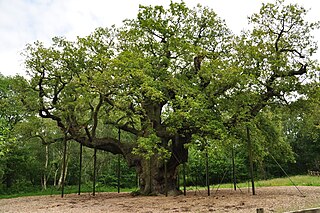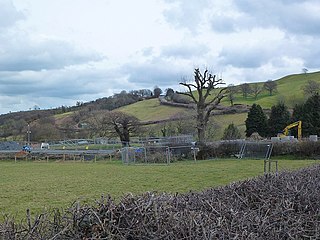
Quercus robur, the pedunculate oak, is a species of flowering plant in the beech and oak family, Fagaceae. It is a large tree, native to most of Europe and western Asia, and is widely cultivated in other temperate regions. It grows on soils of near neutral acidity in the lowlands and is notable for its value to natural ecosystems, supporting a very wide diversity of herbivorous insects and other pests, predators and pathogens.

Quercus ilex, the evergreen oak, holly oak or holm oak is a large evergreen oak native to the Mediterranean region. It is a member of the Ilex section of the genus, with acorns that mature in a single summer.

Quercus petraea, commonly known as the sessile oak, Cornish oak, Irish Oak or durmast oak, is a species of oak tree native to most of Europe and into Anatolia and Iran. The sessile oak is the national tree of Ireland, and an unofficial emblem in Wales and Cornwall.

The Major Oak is a large English oak near the village of Edwinstowe in the midst of Sherwood Forest, Nottinghamshire, England. According to local folklore, it was Robin Hood's shelter where he and his merry men slept. It weighs an estimated 23 tons, has a girth of 33 feet, a canopy of 92 feet, and is about 800–1,000 years old. In 2014, it was voted 'England's Tree of the Year' by a public poll by the Woodland Trust, receiving 18% of the votes. Its name originates from Major Hayman Rooke's description of it in 1790.

Windsor Great Park is a Royal Park of 2,020 hectares, including a deer park, to the south of the town of Windsor on the border of Berkshire and Surrey in England. It is adjacent to the private 265 hectares Home Park, which is nearer the castle. The park was, for many centuries, the private hunting ground of Windsor Castle and dates primarily from the mid-13th century. Historically the park covered an area many times the current size known as Windsor Forest, Windsor Royal Park or its current name. The park is managed and funded by the Crown Estate, and is the only royal park not managed by The Royal Parks. Most parts of the park are open to the public, free of charge, from dawn to dusk, although there is a charge to enter Savill Garden.

Savernake Forest stands on a Cretaceous chalk plateau between Marlborough and Great Bedwyn in Wiltshire, England. Its area is approximately 4,500 acres.

Marton, Cheshire is a small village and civil parish in the unitary authority of Cheshire East and the ceremonial county of Cheshire, England on the A34 road 3 miles (5 km) north of Congleton. Its correct postal address is "Marton, Macclesfield" which avoids confusion with "Marton, Winsford".

Toft is a small village in the South Kesteven district of Lincolnshire, England. It is situated approximately 2 miles (3 km) south-west from Bourne on the A6121. Toft is part of the civil parish of Toft with Lound and Manthorpe. The population of the civil parish at the 2011 census was 333.

Manthorpe is a village in the civil parish of Toft with Lound and Manthorpe, in the South Kesteven district of Lincolnshire, England. It lies 0.5 miles (0.8 km) east from the A6121, 3 miles (5 km) south-west from Bourne and 6 miles (10 km) north-east from Stamford. Manthorpe was formerly in the parish of Witham on-the-Hill, in 1866 Manthorpe became a separate civil parish, on 1 April 1931 the parish was abolished to form "Toft with Lound and Manthorpe". In 1921 the parish had a population of 74.

The Pontfadog Oak was a sessile oak tree that stood on Cilcochwyn farm above the village of Pontfadog, in the Ceiriog Valley west of Chirk in the county borough of Wrexham, Wales, until it was blown over in the early hours of 18 April 2013. At the time it was reputed to be the oldest and largest oak tree in the United Kingdom.

The Queen Elizabeth Oak is a large sessile oak tree in Cowdray Park near the village of Lodsworth in the Western Weald, West Sussex, England. It lies within the South Downs National Park. It has a girth of 12.5–12.8 metres (41–42 ft), and is about 800–1,000 years old. According to this estimate it began to grow in the 11th or 12th century AD. In June 2002, The Tree Council designated the Queen Elizabeth Oak, one of fifty Great British Trees, in recognition of its place in the national heritage. According to the Woodland Trust, the tree is the third largest sessile oak tree to be recorded in the United Kingdom after the Pontfadog Oak in Wales and the Marton Oak in Cheshire, although this tree is now fragmented.

The Darley Oak is a Pedunculate oak tree which grows near Darleyford in the parish of Linkinhorne on the edge of Bodmin Moor, Cornwall, England, UK. This ancient tree is thought to be at least 1,000 years old, and a considerable number of legends take it as their core. Folk tradition attributes healing properties to the tree, and it is said that any wish made to it will eventually come true. Its acorns are also used as amulets, and were once used by pregnant women during pregnancy, to bring them luck. It was chosen one of the 50 Great British Trees by The Tree Council in 2002.
The Buttington Oak was a tree near to Offa's Dyke at Buttington, Wales, said to have been planted to mark the site of the Battle of Buttington between the Vikings and a Mercian, Wessex and Welsh force in 893. It had been cyclically pollarded for timber until around 150 years ago. The oak tree was rediscovered in 2009. In 2017 it was badly damaged by storms, finally collapsing in February 2018. The Buttington Yew, also planted in commemoration of the battle in 893, survives and in 2022 was added to the roster of 70 Ancient Trees in The Queen's Green Canopy.

The King Oak is a tree in the grounds of Charleville Castle, Tullamore in Ireland. Descended from the ancient oak forests that were once commonplace in Ireland, the tree is estimated to be around 400 to 800 years old. The King Oak has been heavily pollarded and is a large tree, with a trunk of 8.29 metres (9.07 yd) girth and some of the lower branches extending as far as 27 metres (30 yd). A superstition associated with the tree says that if one of its branches should fall a member of Bury family, long-time owners of the Charleville Estate, will die. The 1963 death of Charles Howard-Bury has been held as confirmation of this belief, following shortly after the tree was struck by lightning which split its main trunk. The tree was nominated as the Irish entry for the 2013 European Tree of the Year contest, in which it finished third.

The Brimmon Oak is a veteran tree in Newtown, Powys, Wales. A pedunculate oak, it is thought to be around 500 years old and has been on land farmed by the same family since the 1600s. The tree was scheduled to be felled as part of the construction of the A483 Newtown Bypass in 2015 but was saved as the result of a petition. The tree was named both Welsh and British Tree of the Year for 2016 and was runner up in the European Tree of the Year awards of 2017.

Wyndham's Oak is an historic pedunculate oak tree in Silton, Dorset, England. It was one of a number of oaks that historically marked the boundary of between Selwood Forest and Gillingham Forest, a medieval hunting ground.

King Offa's Oak is a pollarded pedunculate oak which grows on the territory of Windsor Great Park, Berkshire, England. The tree is 11.18 metres (36.7 ft) in girth, and the trunk splits 1 metre above ground, leaving several enormous offshoots. The oak is at least 1300 years old according to experts and potentially as old as 1500 years. Both of these numbers would make the tree the oldest oak in the United Kingdom.

The Marton Oak is a large, ancient sessile oak which grows in the village of Marton, Cheshire. The tree has a girth of 14.02 metres (46.0 ft) measured at 1.5 metres off the ground, making it the UK's largest and widest tree since the collapse of the Newland Oak in Gloucestershire, surpassing trees such as the Bowthorpe Oak in Lincolnshire and the three large sweet chestnut trees at Canford School, Dorset. The tree is believed to be 1,200 years old, and is thought to be in the latter stages of its lifespan, as most of the heartwood has rotted away. The tree split into sections centuries ago, but they have one and the same root system. It is not known what the tree looked like before it split.


















